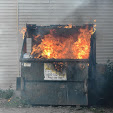
When Smith & Wesson released their .44 Hand Ejector in 1908, it was obviously their flagship handgun. Physically imposing and immaculately finished, most were chambered in a new cartridge called the ".44 Special", to distinguish it from the old, shorter .44 Russian caliber. Distinctive features that set the big .44 apart from its lesser brethren included a third locking detent for the cylinder assembly, mounted at the front of the crane, and a graceful-looking protective shroud for the ejector rod machined below the barrel.
A little over fifteen thousand were sold over the next seven years, making it one of the more sluggish items in the Smith catalog. And no wonder; this Cadillac of revolvers was priced at the princely sum of $21!
Its replacement, dubbed the .44 Hand Ejector 2nd Model, dispensed with the extra locking detent on the crane, as well as the complex and difficult to machine ejector rod shroud, and could be offered for only $19. Despite the ten-percent price cut, the new guns still remained slow-movers compared to their smaller brethren, but they had some fanatical devotees.
Like nearly every change Smith has ever made in a revolver, people almost immediately began complaining about the removal of the ejector rod shroud.
 While some claimed that it was just a place for mud to collect on a military or peace officer's gun, others claimed that it protected the ejector rod from bending should the gun be dropped or used for... um... Percussive Behavior Modification Therapy on an uncooperative bad guy.
While some claimed that it was just a place for mud to collect on a military or peace officer's gun, others claimed that it protected the ejector rod from bending should the gun be dropped or used for... um... Percussive Behavior Modification Therapy on an uncooperative bad guy.The dealer Wolf & Klar in Fort Worth, Texas pleaded with Smith to do a run of the big-bore hand ejectors with the ejector rod shroud, offering to buy up to 3,500 of them. With such a huge offer on the table, Smith agreed, and thus was born the .44 Hand Ejector 3rd Model, sometimes known as the "Model of 1926".
Despite production of the 2nd Model continuing apace, and the two models sharing the same serial number range, the 3rd Models are easy to tell apart by the shroud under the barrel and the differently-shaped knob on the end of the ejector rod. Made famous by users such as Texas Ranger Captain "Lone Wolf" Gonzuallas, the distinctive lines of the taper-barreled, shrouded-ejector rod Model of 1926 were continued after the war as the Model of 1950 .44 Military and the later Model 21.
Less than five thousand of the 3rd Model guns were built between 1926 and S&W ceasing production for the war effort in 1941. Never cataloged as such, they remained a special order item and have gained almost cult-like status with Smith fans. When Clint Smith pestered Smith to bring back a classic big-bore service revolver, the Model 21 .44 Military was the first one he pestered them to resurrect. Part of the reason is that good originals have become so scarce as to be almost too valuable to shoot; a pristine Model of 1926, even assuming no special value modifiers, could be expected to bring $3500-$4000 at auction.
You can imagine my surprise when I saw the man walking through the gun show with a 4", tapered barrel with the distinctive half-moon front sight and shrouded ejector rod protruding from his hand. That's enough to set any S&W fan's gears to turning. "Whatcha got there?" I asked.
"Model 21," he replied.
Five screws. Pre-21, at least. It had a flaking re-nickel job and wore a cracked and yellowing set of godawful hollow plastic fake stag grips. It was all there, though, and seemed mechanically tight...
"How much you gotta get out of it?"
"Three-fifty."
Sold.
Endshake was in spec. Lockup was good. It carried up a little lazy, but that's to be expected and can be fixed. I even had a spare set of N-frame square-butt "Magna" service stocks laying around just waiting to replace the plastic ones.
Truthfully, I was so excited by the find that it wasn't until I got home and really looked it over that I noticed the mushroom-headed ejector rod and lack of both the sliding hammer block and alpha prefix on the serial number that indicated a prewar gun. According to the Standard Catalog of Smith & Wesson, the serial number dated it to 1930.
As a bonus, the bore was pristine, with good, sharp rifling and no pitting. This gun had been carried a lot more than it had been shot. Further, there was a partly-obliterated factory rollmark on the backstrap indicating the gun had been shipped to a police department. Which one will remain a mystery until I get the gun lettered by the factory.
With the model being so rare and highly sought-after, for a collector of my type, this is just the kind of gun I like to find; cosmetically flawed enough to make it affordable and mechanically sound enough to make it shootable. I think I need to look into a good holster for it. If it's good enough for "Lone Wolf" and Clint Smith, it's good enough for me.


